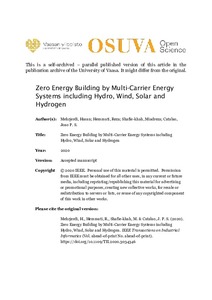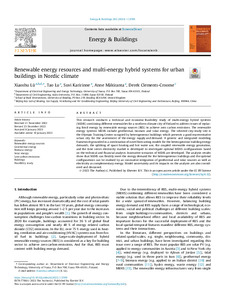Energy Management Systems of Grid-Connected Active Buildings
Shaterabadi, Mohammad; Khajeh, Hosna; Firoozi, Hooman; Laaksonen, Hannu (2022-05-07)
Katso/
Tiedosto avautuu julkiseksi: : 07.05.2024
Shaterabadi, Mohammad
Khajeh, Hosna
Firoozi, Hooman
Laaksonen, Hannu
Editori(t)
Vahidinasab, Vahid
Mohammadi-Ivatloo, Behnam
Springer
07.05.2022
Julkaisun pysyvä osoite on
https://urn.fi/URN:NBN:fi-fe2022062048045
https://urn.fi/URN:NBN:fi-fe2022062048045
Kuvaus
vertaisarvioitu
©2022 Springer. This is a post-peer-review, pre-copyedit version of a book chapter published in Active Building Energy Systems: Operation and Control. The final authenticated version is available online at: https://link.springer.com/book/10.1007/978-3-030-79742-3
©2022 Springer. This is a post-peer-review, pre-copyedit version of a book chapter published in Active Building Energy Systems: Operation and Control. The final authenticated version is available online at: https://link.springer.com/book/10.1007/978-3-030-79742-3
Tiivistelmä
An active building typically owns some flexible energy resources, such as controllable loads, energy storages, or distributed generation units, that can be controlled to reduce the building’s total cost or benefit from providing the grid with required services. In this regard, the energy management system is responsible for scheduling/controlling these resources based on the targets of the active building. In addition, the energy management system needs to take into account the operational cost of each resource, the limits imposed by the owner, and those associated with the power system. This chapter will focus on these targets, objectives, and constraints. Moreover, the chapter reviews some existing algorithms utilized by the building’s energy management methods such as optimization-based, rule-based, and artificial intelligence-based approaches in order to control the flexible appliances of the building optimally.
Kokoelmat
- Artikkelit [2620]
Samankaltainen aineisto
Näytetään aineisto, joilla on samankaltaisia nimekkeitä, tekijöitä tai asiasanoja.
-
Research on the indoor temperature regulation characteristics of a nearly zero energy building with the nonlinear heat capacity building components : A simple model
Zhang, Qunli; Liu, Yimo; Zhang, Qiuyue; Wang, Gang; Lü, Xiaoshu (Elsevier, 13.07.2023)
articleWith establishment of global carbon reduction targets, energy conservation and emission reduction of building is imperative. By passive building design method, nearly zero energy buildings (nZEB) can decrease building ... -
Zero Energy Building by Multi-Carrier Energy Systems including Hydro, Wind, Solar and Hydrogen
Mehrjerdi, Hasan; Hemmati, Reza; Shafie-khah, Miadreza; Catalao, Joao P. S. (Institute of Electrical and Electronics Engineers, 28.10.2020)
articleThis paper proposes a unified solution to address the energy issues in net zero energy building (ZEB), as a new contribution to earlier studies. The multi carrier energy system including hydro-wind-solar-hydrogen-methane-carbon ... -
Renewable energy resources and multi-energy hybrid systems for urban buildings in Nordic climate
Lü, Xiaoshu; Lu, Tao; Karirinne, Suvi; Mäkiranta, Anne; Clements-Croome, Derek (Elsevier, 01.03.2023)
articleThis research conducts a technical and economic feasibility study of multi-energy hybrid systems (MEHS) combining different renewables for a northern climate city of Finland to address issues of replacing fossil energy by ...

